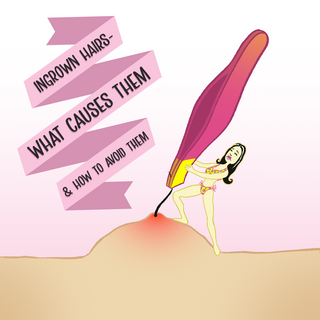
Ingrown Hair What Really Causes Them And How To Avoid Them
Ingrown hair ... We all hate them, we dread them, and sometimes we stop waxing because of them. Is there a solution? Yes. Understanding hair and its growth is the first part of the solution. To fix anything, you must first understand it.
So, just what is an ingrown hair?
An ingrown hair is a condition where the hair doesn’t grow up to the skin surface and exit the follicle. The hair instead gets trapped and grows under the skin, spiraling beneath the surface and causing irritation. Ingrown hair along bikini lines are strong, deep-rooted hairs. Ingrown hairs are unsightly, painful, and may contain pus inside the bump. Ingrown hair is more common in people who have very curly or coarse hair. Curly hair is more likely to bend back and re-enter the skin. The goal of waxing is to remove the entire hair from the follicle but often it can break either above or below the skin’s surface. Ingrown hair is not serious, but it can be irritating and embarrassing. Occasionally you may need to refer your client to a doctor.
CAUSES OF INGROWN HAIR:
Broken/Snapped Hair:The main cause is wax application. If you do not get the wax to the skin and the base of the hair it can break. You can avoid breaking hair by applying the wax with more pressure and using the correct angle on your applicator stick. You must get the wax to the base of the hair at the skin level to reduce the chances of breaking the hair. If you do not use enough pressure when applying the wax, the hair will break easily. You may think you did a great job, but when your client comes in for the next appointment, you will see the ingrown hair. One of the biggest mistakes new estheticians make is not using enough pressure. Another cause of broken hair is removing the hair in too large of a strip. With smaller strips, your pulls are more even in pressure, resulting in less broken and/or snapped hair. When you learn this proper technique, your waxing will improve 1,000%.
Snapped hair resembles a curling ribbon. You start with a long piece of ribbon and with the edge of the scissors you run the ribbon along the edge causing it to curl. Hair does the same thing when it’s broken or snapped. It curls and goes back into the hair follicle. This hair can grow just about any way it wants. Growing across the skin is what it usually does. In time you will see a hair growing sideways under the skin. Sometimes this hair can be quite long, depending on how long ago it was broken or snapped. It is best to just leave this hair alone instead of digging it out. If it is growing, it is still attached to the root. Digging it out can cause scarring and can be quite uncomfortable. If you continue to exfoliate (think of a sand dune you have to wear down) the hair will eventually come to the surface of the skin and can be removed easily.
Infected Ingrown Hair:Hair Growth:
Exfoliation & Why It's Important:
Now hold your left hand, with fingers closed in front of you. Now gently and slowly push your right index finger between the two fingers on your left hand. This represents your hair breaking through the skin. Now imagine layers upon layers of dead skin resting on top of that skin. The shaved hair is strong and can break through that dead layer of skin. However, the waxed hair now has a fine tip and the more you wax, the weaker that hair becomes and it simply cannot break through that dead skin. Exfoliation removes the dead skin build-up we accumulate each day and allows that waxed hair to break through the surface.
Exfoliate before waxing to remove dead skin build-up and to achieve a better overall wax. Exfoliation also reduces the chances of excess dead skin cells from entering the open follicle after waxing. I recommend an exfoliating mitt in the shower, as well as Scrub ‘Me ‘Luscious®, which is a water-based, full-body microdermabrasion scrub, that gently removes the dead skin and does not interfere with the waxing process. I recommend you use Scrub ‘Me’ Luscious® twice a week in addition to using the shower mitt.
After-care products are also very important. I developed Get the Bump Outta Here!® which contains all natural derivatives of salicylic, lactic, and glycolic acids. The alcohol in the base dries out the infection and the acids give a gentle but effective mini flash peel. I believe in acids for ingrown hair for one simple reason, ... they work!
Get the Bump Outta Here!® was created for all skin types, including sensitive skin. It is safe to use several times a day if needed. It will not dry out, burn, cause peeling or crack the skin. The key to being ingrown hair free is constant mild exfoliation!
Before & After You Wax:- No tight clothes. Tight clothes block the hair from getting to the surface. You may notice your client’s have ingrown hair along their panty line. Their underwear is too tight. Suggest they get some better fitting or non-elastic leg panties. Also, thong underwear can cause ingrown hairs on the backside. If you have nurses as clients, many wear support hose or tights resulting in ingrowns on their thighs, legs, and butt.
- Have your clients start to exfoliate the day after waxing.
- Friction of any kind can cause ingrown hair. You will notice bike riders have ingrowns on their butts.
- Use quality sunblock on freshly waxed skin. Of course, sunblock is recommended every day!
- When waxing a man’s back or chest, suggest he bring a clean t-shirt to his appointment. He may have been sweating and the sweat from a dirty t-shirt can cause irritation.
- If you have someone prone to irritation, breakouts, or histamine reactions. I suggest they also bring along a tube of Polysporin or Benadryl to their appointment. I suggest this for all first time clients getting a back, chest, face, or Brazilian wax. Polysporin is an antibiotic made for burns that allows oxygen to reach the skin. Do not have your client use Neosporin. Neosporin seals the area and can make the issue worse.
- No swimming for at least 24 hours. This includes lakes, pools, and hot tubs. No sex for 24 hours as well. Hair follicles are open and prone to infection at this time.
When a person first starts waxing, especially on the face, bikini, or back, they may break out. This is most likely not an allergic reaction to the wax and it is not pimples. What is it? Waxing is a trauma to the skin, no matter how you look at it, it’s a trauma. 70% of the time the follicle and hair shaft stops swelling when it reaches the surface, 30% of the time it does not. Those bumps on the skin are hair follicles that have swollen



